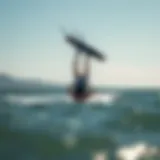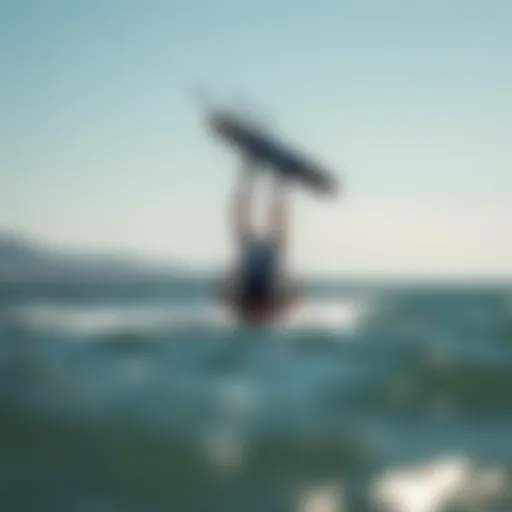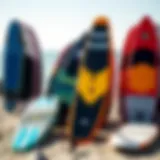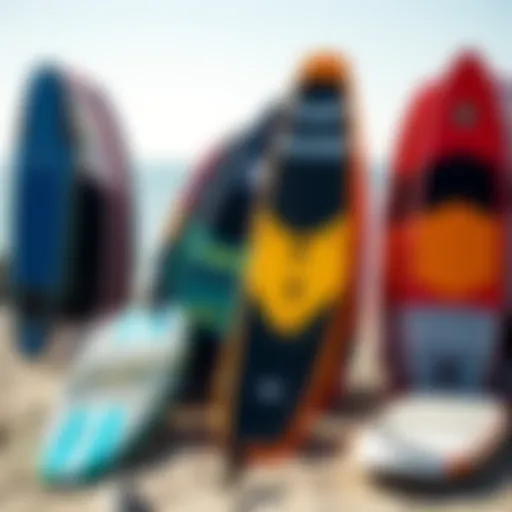Seaside Heights Weather Insights for Kiteboarding Enthusiasts
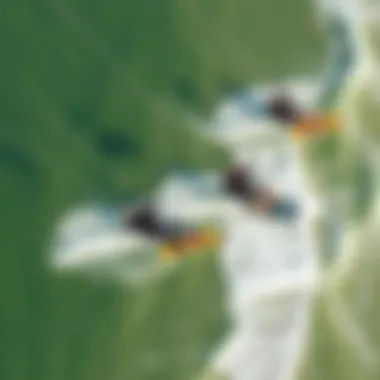

Intro
Seaside Heights, a quaint beach town on the Jersey Shore, is synonymous with sun, sand, and surf. However, for kiteboarders, it’s the understanding of the local weather that can make or break a session on the water. Each season rolls in with its unique characteristics, shaping the riding experience for enthusiasts and professionals alike. As the winds shift and temperatures fluctuate, knowing what to expect can enhance your enjoyment and safety.
In this guide, we will dissect the weather patterns prevalent in Seaside Heights. We will delve into how the myriad of seasonal changes intricately weaves into kiteboarding conditions. From wind patterns that fill the sails to the temperature shifts that affect gear choices, a comprehensive grasp of these elements will help kiteboarders maximize their time on the waves.
By the end of this deep dive, you'll have a clearer view of the climatic trends at Seaside Heights, equip yourself with practical knowledge on gear and techniques, and understand the optimal timmings for hitting the water.
Gear Insights
When it comes to kiteboarding, selecting the right gear can significantly impact performance and safety. Each piece plays a crucial role, and knowing which ones are best suited for the varying conditions in Seaside Heights is essential.
Latest Gear Reviews
Kiteboarding technology is continuously advancing. Every season brings in new manufacturers and models that claim to improve performance. The right gear for you might be the difference between an exhilarating ride and one that's less than comfortable. Here’s a brief overview of some of the top-rated gear currently making waves:
- North Kiteboarding Orbit: This kite has garnered attention for its stability and versatility in a range of wind conditions, making it a solid choice for all levels of kiteboarders.
- Slingshot Darkside Wakeboard: It's a sturdy board known for its durability and responsiveness. Ideal for those who want to push their limits with tricks and jumps, especially during the gusty autumn winds.
Essential Gear for Beginners
For those just dipping their toes into the kiteboarding world, it’s crucial to have the right essentials:
- Kites: Start with a size appropriate for your weight and local wind conditions, typically between 7 and 12 meters.
- Harness: An easy-fit waist harness can reduce pressure on the lower back and provide better control.
- Safety Leash: Never overlook safety; a reliable leash will keep you connected to your kite.
Investing in quality gear is wise, but so is understanding local conditions. Bringing out the right kite that corresponds with the daily forecast is key.
Techniques and Tips
Enhancing your skills in kiteboarding involves more than just having the right equipment. Knowing some techniques and safety practices can ensure you have better experiences on the water.
Advanced Tricks and Techniques
As you progress, incorporating advanced tricks can elevate your riding.
- Jumping: Mastering your jumps requires understanding the wind's dynamics and timing your take-off.
- Backrolls and Frontrolls: These tricks combine the thrill of freestyle with a touch of acrobatics. Start practicing these with gentle wind conditions to avoid major falls.
Safety Practices for Kiteboarders
Safety should always be paramount.
*"Remember, it’s better to be a cautious kiteboarder than an injured one. Take your time to master the basics before attempting tricks."
Here are some safety practices to keep in mind:
- Check the Weather: Always check local forecasts on websites like Weather.gov or AccuWeather before heading out.
- Buddy System: Kiteboarding with a friend not only enhances the fun but also ensures help is at hand in case things go awry.
- Know Your Limits: Don’t overestimate your skills. Conditions can change rapidly
To become proficient in kiteboarding at Seaside Heights, knowing the local weather is paramount. Whether one is an instructor or a thrill-seeking beginner, understanding weather patterns will significantly elevate the kiteboarding experience.
Preface to Seaside Heights Weather
Understanding the weather in Seaside Heights is vital, especially for those involved in kiteboarding. The conditions here can transform dramatically from season to season, creating a vibrant but sometimes unpredictable environment for enthusiasts. Kiteboarders, in particular, are always on the lookout for favorable winds, temperature variances, and precipitation patterns. Having this knowledge can change an average outing into an exhilarating adventure or a mundane day on the beach.
Geographical Context
Seaside Heights is a coastal town located on the barrier island of the New Jersey Shore. With the Atlantic Ocean to the east and the Barnegat Bay to the west, the geography plays a pivotal role in weather patterns. The convergence of oceanic and bay currents greatly influences the wind and temperature, creating unique microclimates. The town experiences maritime influences that can lead to sudden changes in weather, often leaving those unprepared at the mercy of changing conditions.
Coastal geography also means that sea breezes can kick in when least expected, making it necessary for kiteboarders to stay alert for shifts in the environment. This interaction between land and water bodies creates distinct seasons, each with its own set of characteristics.
Importance for Kiteboarding
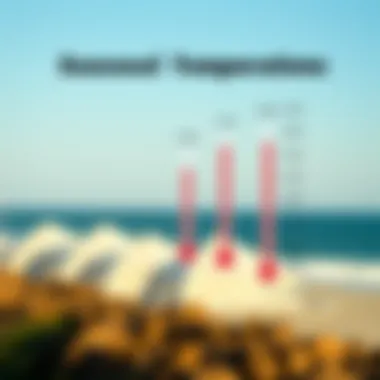
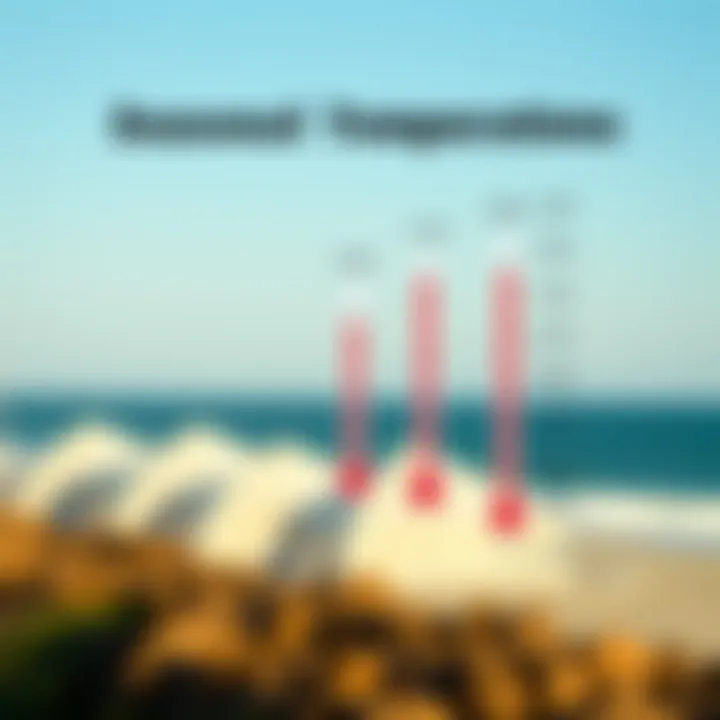
Kiteboarding in Seaside Heights offers an array of conditions that can either encourage or challenge a rider. Understanding these weather nuances is crucial for anyone looking to catch wind on their board. From late spring to early fall, the wind patterns tend to be ideal for kiteboarding, providing consistent gusts that are neither too harsh nor too calm. However, bad weather can creep up out of nowhere, and having a solid comprehension of local forecasts can mean the difference between safe riding and endangering oneself.
Here are a few reasons why weather knowledge is critical for kiteboarders:
- Safety: Lightning or sudden gusts can pose serious risks, so being informed about weather alerts can save lives.
- Optimal Conditions: Knowing when to hit the water increases the likelihood of experiencing the best possible conditions, maximizing enjoyment.
- Equipment Preparation: Different weather conditions dictate different gear requirements, ensuring that the right equipment is on hand to suit the day’s weather.
"Good weather is a kiteboarder's best friend, but unpredictable weather is often a ride's worst enemy."
The heart of kiteboarding includes the thrill of mastering the elements, and to ride safely and effectively, one must respect those same elements. Thus, diving into a thorough examination of Seaside Heights weather will only enhance the experience, making the information provided invaluable to riders at all levels.
Climatic Overview
Understanding the climatic conditions of Seaside Heights is paramount for both locals and visitors alike. This section delves into the intricate seasonal weather patterns and temperature trends that shape the area, especially regarding kiteboarding. Having a solid grasp of the climate can dictate the best times to hit the waves or even when to stay inside and enjoy a warm cup of coffee.
Seasonal Weather Patterns
Spring Conditions
Spring in Seaside Heights is a breath of fresh air after the often chilly winter months. From March to May, temperatures begin to rise, with averages sitting around 50-70°F. The key trait during this season is the variability. One moment, you might be basking in the sun, and the next, a cool breeze brings a chill. This fluctuation can be both a blessing and a curse for kiteboarders. On one hand, the warming waters start to draw enthusiasts out. On the other hand, sudden shifts in weather can catch unprepared kiteboarders off guard. The blossoming flowers and returning flocks of birds only add to the charm, making spring a favored time for kiteboarding if the weather cooperates.
Summer Patterns
Ah, summer in Seaside Heights! Usually from June to August, it often boasts sweltering temperatures that hover around 70-85°F, making it prime season for beach lovers. This time is when kiteboarding truly thrives, with almost predictable wind patterns and warmer waters. However, don’t forget, with good weather comes a crowd. Beachgoers can fill up the shores, and it can get quite crowded during peak weekends. Strong afternoon thermals can create thrilling conditions for kiteboarding, but the risks escalate as safety becomes integral when frolicking with the masses while riding the waves.
Autumn Transitions
As the leaves begin to change colors, Seaside Heights transitions into a stunning autumn, roughly from September to November. Temperatures slide down to more comfortable levels, spanning 50-75°F. The crisp air makes it nice for kiteboarding, especially in September when the summer heat lingers. The often quieter beaches attract those wanting a more laid-back experience, making it an appealing choice for kiteboarders looking for less competition on the water. However, the unpredictability of wind patterns as the seasons shift can add an interesting challenge to the mix.
Winter Influences
Winter approaches with its own set of challenges in Seaside Heights. Bringing frigid temperatures that can dip to 30°F or lower, it is mainly deemed off-season for kiteboarders. The winds can still be fierce but the danger of freezing temperatures can make it quite risky. Some hearty adventurers may appreciate the solitude and the challenge, but generally, most enthusiasts choose to hang up their boards during this time. However, if one manages to take on the elements with the proper gear, winter sessions often offer clear, stunning views of the coastline blanketed in snow.
Temperature Trends
Average Monthly Temperatures
Monthly temperature averages serve as an important guide for residents and kiteboarders alike. With the spectrum of temperatures ranging in summer up to 85°F, while winter can bring chills below 30°F, being informed about what to expect month by month ensures a better preparation. The data is crucial for planning kiteboarding sessions—it allows enthusiasts to choose their best time to enjoy the ocean while also being mindful of safety measures necessary for kiteboarding.
Extreme Weather Variations
Extreme weather variations can occur in Seaside Heights, particularly during storm seasons or cold fronts. These fluctuations are significant for kiteboarding safety. Understanding past instances of storms or freezing temperatures helps prepare kiteboarders for potential risks, from sudden erratic wind gusts to dangerous water conditions. Adapting to changing weather conditions is thus imperative for a safety-first approach to the waters in Seaside Heights.
Wind Patterns and Their Significance
Understanding wind patterns is essential for anyone considering kiteboarding in Seaside Heights. The strength and direction of the wind can significantly affect both the safety and enjoyment of kiteboarding. High winds may offer exhilarating rides, but they also pose risks that demand awareness and respect. The local wind patterns shape not just the conditions for kiteboarding but also impact surfing, sailing, and various beach activities.
Common Wind Directions
In Seaside Heights, the prevailing winds come from the east and northeast. These off-shore winds can create ideal conditions for kiteboarders looking for larger waves and consistent gusts. Here’s a breakdown of some common wind directions:
- East: Winds from the east often provide steady conditions. These winds are perfect for both novice and seasoned kiteboarders as they allow for easier launches and landings.
- Northeast: Winds from this direction can generate choppy water, but they also tend to be steadier. Kiteboarders may find this direction favorable due to its predictability.
- Southeast: While less common, southeast winds can create slightly rougher conditions. Kiteboarders should be more cautious with this wind direction, keeping an eye on sudden gusts.
Understanding these directions helps in planning sessions effectively, ensuring safety and maximizing enjoyment on the water.
Wind Speed Analysis
Average Wind Speeds
The average wind speeds in Seaside Heights fluctuate throughout the year, influencing kiteboarding conditions directly. Generally, kiteboarders can expect:
- Spring: Average speeds typically range from 10 to 15 knots. This gentle breeze is safe for beginners and pleasant for intermediate riders.
- Summer: Winds often pick up, averaging around 15 to 20 knots. It's during this time that kiteboarding truly shines, with afternoon thermals adding excitement to every session.
- Autumn: Winds begin to moderate, averaging about 12 to 18 knots, allowing for comfortable rides amid beautiful fall scenery.
- Winter: A drop to 8 to 12 knots is common, where kiteboarders must gauge comfort against chillier temperatures.

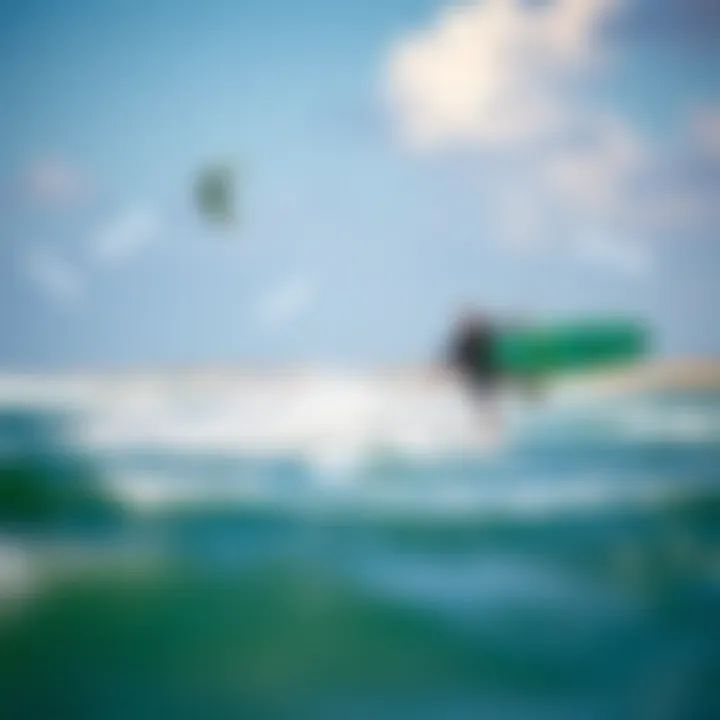
These averages reveal why kiteboarding in Seaside Heights aligns closely with seasonal changes. For kiteboarders, understanding these patterns is critical for ensuring their safety and improving their skills in varying wind conditions.
Windy Days Overview
Seaside Heights experiences a variety of windy days throughout the year, particularly from late spring to early autumn. On average, kiteboarders can expect:
- Late Spring: About 90 days with favorable wind conditions for kiteboarding. This season is often a hive of activity as enthusiasts flock to the beach.
- Summer: More than 100 days with optimal winds. Beach culture thrives, creating a vibrant community of kiteboarders eager to take advantage of the waves.
- Autumn: Windy days decrease, but excitement doesn't fade. Around 70 days still present great conditions.
- Winter: A quiet time for kiteboarding, with only about 30 days considered suitable due to lower wind speeds and temperatures.
These windy days underscore the importance of planning and being prepared. Kiteboarders should always monitor the forecasts before heading out. Failing to do so can lead to unfavorable conditions and riskier experiences on the water.
"Knowing when and how to ride the wind not only makes the experience easier but also ensures a greater sense of safety and adventure at sea."
Whether you choose to brave the winds or wait for the ideal conditions, being informed will make all the difference between an exhilarating ride and a challenging session on the water.
Precipitation Patterns
Understanding precipitation patterns is crucial for anyone who's keen on kiteboarding in Seaside Heights. The interplay of rainfall and the weather directly affects both the conditions on the water and the experience of riders. By comprehensively analyzing these patterns, kiteboarders can optimize their time spent on the waves, making the most out of favorable conditions while avoiding poor weather.
Monthly Rainfall Averages
Seaside Heights experiences its fair share of rainfall throughout the year. Knowing the monthly averages can provide insight into potential days for kiteboarding. Generally, the area sees an increase in precipitation from summer through early autumn, which can heavily influence wind conditions and water levels.
Here’s a breakdown of what to expect on average:
- January: 3.5 inches
- February: 2.8 inches
- March: 3.9 inches
- April: 3.1 inches
- May: 3.0 inches
- June: 3.0 inches
- July: 3.4 inches
- August: 3.8 inches
- September: 4.1 inches
- October: 4.0 inches
- November: 3.7 inches
- December: 3.9 inches
These figures showcase that September typically gets the most rain. Kiteboarders should keep an eye on these averages and plan for possible interruptions in their sessions. The rain can often lead to shifts in wind patterns, which can be either a blessing or a challenge, depending on the timing and severity.
Impact on Kiteboarding
So, what does all this mean for those geared up to hit the water? Well, understanding rainfall can significantly influence kiteboarding decisions. For one, precipitation typically means shifting wind conditions. Days before a rainfall event, the winds can pick up, providing ideal conditions for kiteboarding. Conversely, intense rain can lead to poor visibility and choppy waters, which are far from ideal for enthusiasts.
Additionally, too much rain can affect beach conditions, making the launch areas muddy or unstable. Thus, kiteboarders must be aware of these potential pitfalls:
- Pre-Weather Check: Checking the radar before heading out can save a lot of trouble.
- Wind Adjustments: After rainfall, winds can become gusty and unpredictable.
- Safety Precautions: Wet conditions can complicate retrieval and launch of gear.
Weather Monitoring Resources
In the ever-changing realm of weather, staying informed is crucial, especially for kiteboarding enthusiasts who rely on favorable conditions. Understanding where to find accurate and timely weather information can be a game changer for planning outings. This section illuminates the key resources available for monitoring weather in Seaside Heights, focusing on the specific advantages and considerations relevant to kiteboarding.
Online Weather Services
With a wealth of information at your fingertips, online weather services play a vital role in providing real-time updates and forecasts. Websites like Weather.com and AccuWeather.com offer comprehensive weather data, including temperature, wind speed, and precipitation forecasts. Here are a few features that make these services indispensable:
- Interactive Forecasts: Real-time data, which means you can track changes as they happen, allowing for last-minute adjustments to your plans.
- Detailed Radar Maps: Visual representations of weather systems in the area help you gauge conditions better.
- Custom Alerts: Many services allow you to set notifications for specific weather conditions, so you won't miss when the wind picks up or a storm approaches.
Furthermore, these platforms often provide seasonal insights, helping you prepare for varying kiteboarding conditions throughout the year. Users can check not just daily forecasts, but seasonal patterns, equipping them with knowledge to choose the best times for their kiteboarding adventures.
Local Forecasting Stations
In addition to online resources, local forecasting stations offer invaluable insights tailored to Seaside Heights. Radio stations, news channels, and local meteorological offices provide forecasts that often include hyper-local updates reflecting the unique coastal conditions. They may not have the same reach as larger online services, but their localized expertise is indispensable.
Some key advantages include:
- Localized Knowledge: Meteorologists who understand the particular nuances of coastal weather are better equipped to predict sudden changes that might not be reflected in broader forecasts.
- Community Connection: Many local stations encourage community involvement, offering a chance to share real-life reports that can benefit fellow kiteboarders.
- Specialty Updates: These stations may offer specific insights, such as when water temperatures reach optimum levels for kiteboarding or when particular weather patterns are best avoided.
Ultimately, relying on a blend of both online and local forecasting resources ensures that kiteboarders have a well-rounded understanding of weather conditions. Utilizing these tools can help you make informed decisions, enhancing both safety and enjoyment while engaging in this exhilarating sport.
Quote: “Weather is what you expect; climate is what you get.” This saying reflects the importance of monitoring both immediate weather and broader seasonal trends for the best kiteboarding experience.


Stay informed and make use of these weather monitoring resources to ensure that you catch the winds just right!
Coastal Geography and Weather Influence
The coastal geography of Seaside Heights is more than just a beautiful backdrop; it plays a pivotal role in shaping the region's weather patterns. Understanding this influence is crucial for kiteboarders and outdoor enthusiasts who plan activities along the vibrant shore. The unique interplay between landforms and surrounding bodies of water not only contributes to the climate but also affects wind patterns, precipitation levels, and temperature fluctuations.
Role of Water Bodies
Water bodies, notably the Atlantic Ocean, are the heartbeat of Seaside Heights’ climate. They moderate temperatures throughout the year, offering a cooling effect during the summer and providing warmth in winter. The ocean absorbs heat and releases it slowly, which can lead to milder weather during transitional seasons. This characteristic is especially important for kiteboarders, as more stable temperatures result in more favorable conditions for kiteboarding.
Furthermore, the presence of water influences humidity levels. Elevated humidity can lead to foggy mornings, which are common in late spring or early summer. These fogs can dissipate as the sun rises higher in the sky, revealing ideal conditions for kiteboarding later in the day.
"Understanding the role of water bodies helps kiteboarders time their sessions for optimum conditions."
However, there's a flip side; oceanic currents can sometimes lead to unpredictable weather. Sudden changes in wind direction or intensity can occur. Such shifts highlight the necessity for kiteboarders to stay alert and adapt quickly to changing circumstances. Knowledge of water bodies' role in weather can significantly enhance the kiteboarding experience.
Topographical Effects
The topography of Seaside Heights isn't flat; it consists of sand dunes and slight elevations that can affect local winds significantly. These landforms act like obstacles, redirecting winds and creating varying conditions that kiteboarders should be aware of. For those familiar with surfing or pricing the Gulf Stream's energetic sports, wind patterns shaped by topography can lead to notably different conditions in close proximity.
For instance, when winds blow from the land toward the sea, low-lying areas may experience calmer conditions, while hills or dunes may amplify the winds. In areas protected by a dune line, kiteboarders might find a reduced windspeed, creating a perfect environment for beginners to hone their skills without the overpowering gusts. Conversely, on the opposite side, where the winds might be unrestricted, experienced kiteboarders can experience thrilling high-wind conditions that challenge their abilities.
In essence, the interplay of coastal geography and kiteboarders' experiences can’t be overstated. Whether it's gauging wind patterns or understanding temperature variations, kiteboarders will benefit significantly from a comprehensive understanding of these geographical influences. This awareness empowers them to make informed decisions that enhance both safety and enjoyment.
Safety Considerations for Kiteboarders
Kiteboarding, while thrilling, is not without its pitfalls. As with any water sport, being aware of the weather conditions and making informed choices can mean the difference between a memorable day and a disastrous one. For those drawn to the waves at Seaside Heights, taking a moment to consider safety is paramount.
Understanding Weather Alerts
Weather alerts are crucial for kiteboarders. These notifications serve as timely warnings that can help in avoiding dangerous situations. Kiteboarders should familiarize themselves with local weather advisories. For instance, the National Weather Service provides alerts on wind patterns, thunderstorms, and other significant weather events that can impact kiteboarding conditions. By keeping an ear to the ground, or rather the sky, kiteboarders can be proactive in planning their outings.
Common types of alerts include:
- Severe Thunderstorm Warnings: These indicate thunderstorms produced hail, strong winds, and sometimes lightning – elements that can endanger anyone on the water.
- Gale Warnings: Perhaps not ideal for kiteboarding, these signals indicate sustained winds that exceed safe tripping points.
- Small Craft Advisories: When sailing and similar activities become risky due to high winds or rough waters, these advisories are particularly useful.
It’s a good idea to have a reliable weather app on hand. Some popular apps provide real-time updates and notifications about changing weather patterns, making them a great ally for kiteboarders looking to make safe choices during their sessions. Keeping devices charged and accessible ensures that you are always in touch with the latest information.
Best Practices for Risk Management
Understanding how to manage risk while kiteboarding significantly enhances safety. Here are several strategies to keep in mind:
- Conduct Pre-Session Checks: Assess the conditions before hitting the water. Check wind direction, wave heights, and weather forecasts. Knowing what’s coming can help you prepare for the unexpected.
- Know Your Limits: Recognizing your proficiency level really plays a role in staying safe. If it’s a particularly windy day and you're not too experienced, it may be better to stay ashore.
- Buddy System: Kiteboarding with a partner is always wise. Not only does it enhance the fun, but having a friend around ensures that someone’s watching your back in case of troubles.
- Have A Plan: Understand your exit points and where the safest spots are if conditions worsen. Knowing the area can help you make quick decisions if needed.
- Use Proper Gear: Updating your safety gear, such as wearing impact vests and ensuring your kite is in proper working condition, is vital. Don’t skimp in this area; your equipment is crucial.
“Safety isn’t just a buzzword; it’s the foundation of every successful kiteboarding adventure.”
In summary, kiteboarding in Seaside Heights can be a fantastic experience, but it's crucial to prioritize safety measures. By staying informed about weather alerts and following best practices for risk management, kiteboarders can enjoy the waters while minimizing potential hazards. Whether you are an experienced kiteboarder or a novice, adhering to these guidelines will help ensure an enjoyable and safe experience on the waves.
Ending
In closing, understanding the weather patterns in Seaside Heights emerges as a vital element for anyone looking to dive into the world of kiteboarding. With kiteboarding being inherently influenced by wind conditions, temperature variations and precipitation, this comprehensive overview sheds light on critical insights that could enhance your time on water and keep you safe.
Recap of Key Insights
Through our exploration of Seaside Heights' weather, several key elements stood out:
- Seasonal Variability: Each season presents its unique charm and challenges. From the gentle breeze of spring to the turbulent winds of autumn, kiteboarders must adapt to these changing conditions to optimize their performance.
- Wind Dynamics: The statistics on wind patterns indicate that kiteboarders should keep an eye on common wind directions and average wind speeds throughout the year to align their activity with favorable conditions.
- Precipitation Impact: Monthly rainfall averages not only dictate dry days for kiteboarding but also inform on water conditions, which affects overall performance.
- Safety Precautions: The need for staying aware of weather alerts and practicing solid risk management cannot be overstated. Keeping track of sudden weather shifts can be the difference between an enjoyable day on the water and a hazardous situation.
Final Thoughts on Kiteboarding in Seaside Heights
As you plan your kiteboarding sessions in Seaside Heights, consider that knowledge is as crucial as skill. The week-to-week and month-to-month variations in weather conditions create an ever-changing tapestry. A kiteboarder equipped with the understanding of these environmental factors has a better chance of not only experiencing successful sessions but also ensuring the safety of themselves and others.
The coastal charm of Seaside Heights provides a backdrop that goes beyond just picturesque views; it offers a unique experience that is colored by the weather. Therefore, being proactive in seeking out reliable forecasts, monitoring conditions, and continuously educating oneself about best practices will enrich the kiteboarding experience manifold.
"The winds of change blow for those who know how to steer their kite."
Stay informed, stay safe, and enjoy every moment you're out there riding the waves!




